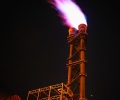US spot gas, futures prices tumble as seasonal demand underwhelms

Cash natural gas prices at hubs in every US region were down sharply in Dec. 1 trading as mild weather pushed residential-commercial heating demand to multiyear lows, underwhelming US gas markets.
New England gas prices were among the hardest hit with Boston’s Algonquin city-gates dropping nearly $3 on the day to just $4.99/MMBtu. Further south, prices at New York metro-area hubs Transco Zone 6 and Texas Eastern M3 were down about 45-50 cents, both trading comfortably below $4/MMBtu.
In the US Midwest, cash prices at Chicago’s NGPL Nipsco hub were down about 21 cents from the prior day to $3.93/MMBtu for Dec. 2 flows. In the Southeast, spot prices at the US benchmark Henry Hub fell 28 cents on the day to $4.23/MMBtu — the hub’s lowest since late August, S&P Global Platts data showed.
On the West Coast, prices at the SoCal Gas city gate dropped more than 60 cents on the day to $4.62 while PG&E city-gates was down just 21 cents to $4.69/MMBtu, Intercontinental Exchange data showed.
The across-the-board drop in cash prices accompanied a decline in res-comm demand on Dec. 1 in every US region except the Midwest. At the US level, heating demand fell more than 3.5 Bcf, or about 10%, from the prior day to 32.1 Bcf — its lowest early-December level since 2017.
According to a short-term forecast from S&P Global Platts Analytics, heating demand should bottom out at 28.5 Bcf on Dec. 2 and track close to the five-year low for the next week at about 35.9 Bcf/d.
NYMEX
On the NYMEX, the Henry Hub prompt futures price also continued losing ground in Dec. 1 trading, falling 30 cents to just $4.26/MMBtu — a fresh three-month low for the contract.
On Nov. 30, the prompt-month price broke through a key technical support level around $4.80/MMBtu, according to Stephen Schork, principal of The Schork Report. In a telephone interview, he attributed the decline in futures prices to the failure of early winter heating demand to materialize.
As seasonal res-comm and power burn demand come increasingly into focus, natural gas cash and futures prices now appear increasingly tethered to near-term weather forecasts.
In its latest six to 10-day outlook, the US National Weather Service predicted milder-than-normal temperatures for nearly the entire US, excluding small portions of the upper Midwest and the Northeast. The agency’s eight to 14-day outlook looks more bearish for the gas market with as much as a 50% chance for above-average temperatures in key heating regions, including the US Northeast and the Midwest.
Supply
Mild weather and weak seasonal heating demand have collided recently with an uptick in gas supply.
Over the past six weeks, US production has surged by nearly 4 Bcf/d, or about 4%, as producers respond to historically elevated prices and internal rates of return at the wellhead. Over the past week, US output has averaged over 95 Bcf/d – up from levels closer to 91 Bcf/d in mid-October, S&P Global Platts Analytics data shows.
The increase in available supply has also allowed US gas storage levels rise vis-à-vis the historical average. At an estimated 3.623 Tcf, US inventory levels for the week ended Nov. 19 were just 58 Bcf behind the prior five-year average. In September, inventories had reached as much as a 235 Bcf deficit, data from the US Energy Information Administration showed.
Source: Platts

 Hellenic Shipping News Worldwide Hellenic Shipping News Worldwide, Online Daily Newspaper on Hellenic and International Shipping
Hellenic Shipping News Worldwide Hellenic Shipping News Worldwide, Online Daily Newspaper on Hellenic and International Shipping























 PG-Software
PG-Software